
How to Use MPU6050: Examples, Pinouts, and Specs
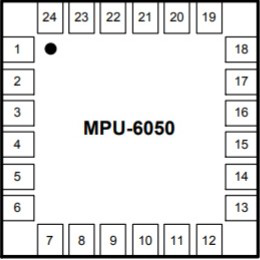
 Design with MPU6050 in Cirkit Designer
Design with MPU6050 in Cirkit DesignerIntroduction
The MPU6050 is a 6-axis motion tracking device that integrates a 3-axis gyroscope and a 3-axis accelerometer into a single chip. This compact and versatile sensor is widely used in applications requiring motion sensing and orientation detection. Its ability to measure angular velocity and linear acceleration makes it ideal for robotics, drones, gaming devices, and mobile applications. Additionally, the MPU6050 features a Digital Motion Processor (DMP) that can process complex motion algorithms on-chip, reducing the computational load on the host microcontroller.
Explore Projects Built with MPU6050
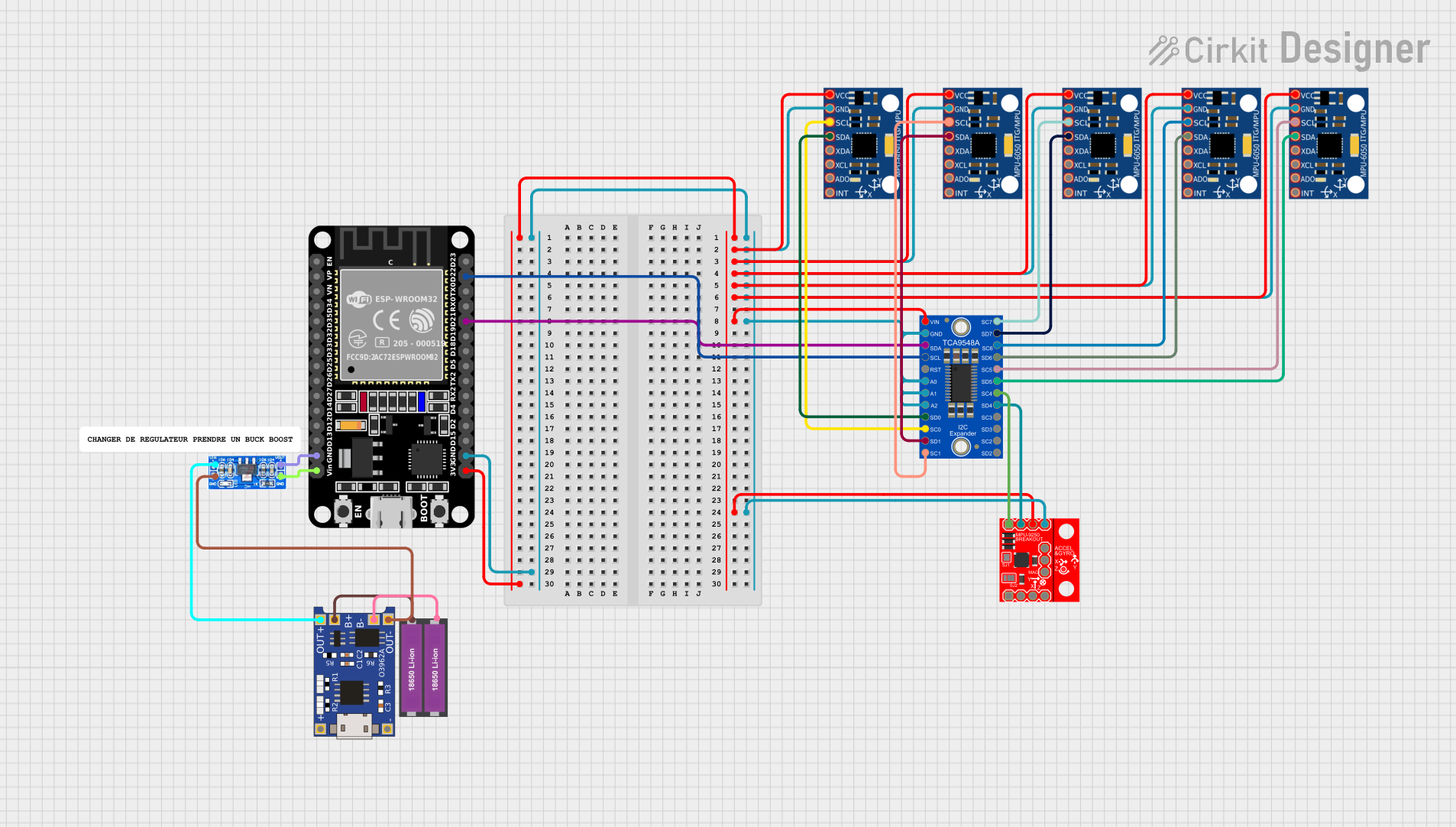
 Open Project in Cirkit Designer
Open Project in Cirkit Designer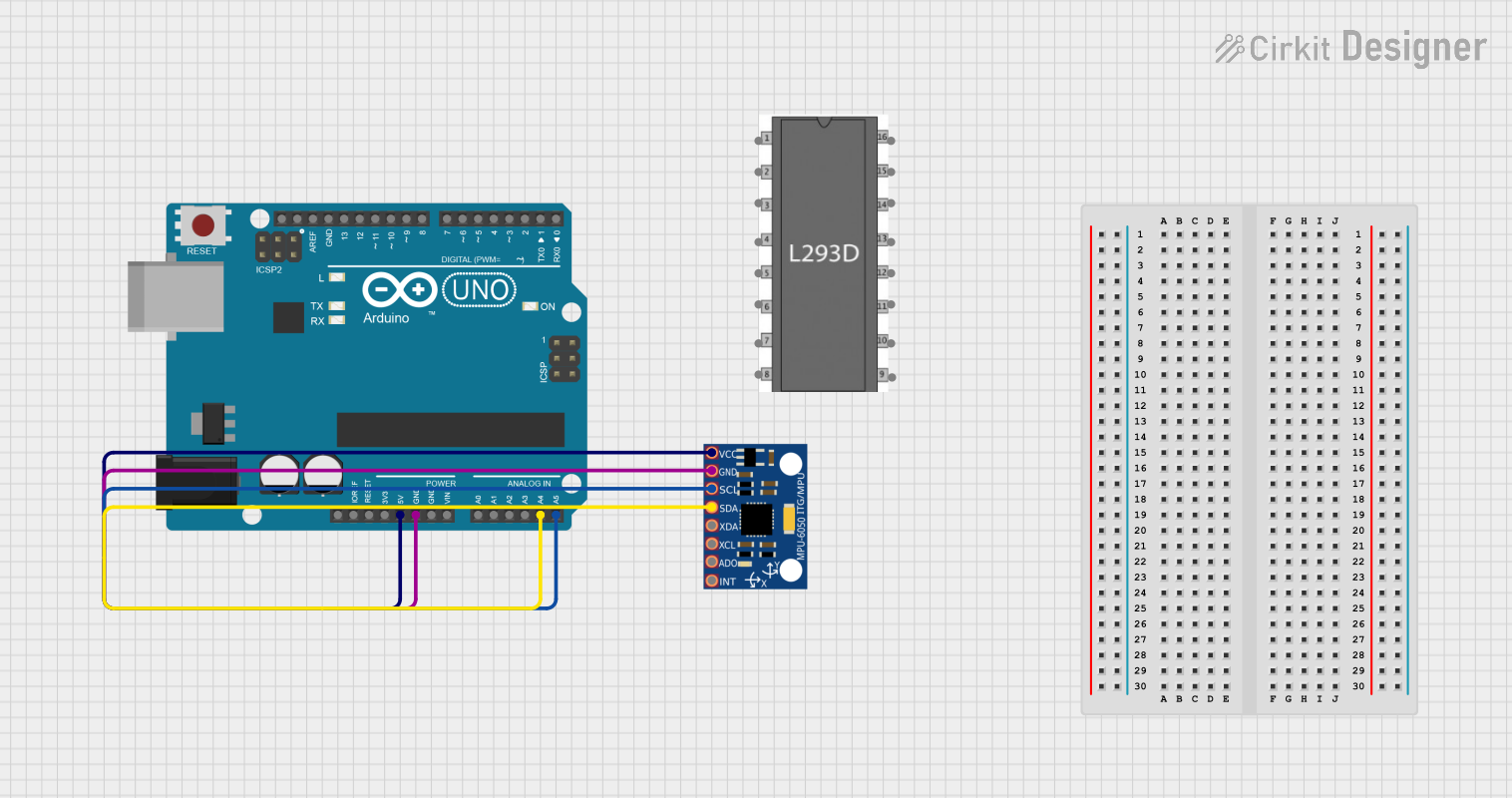
 Open Project in Cirkit Designer
Open Project in Cirkit Designer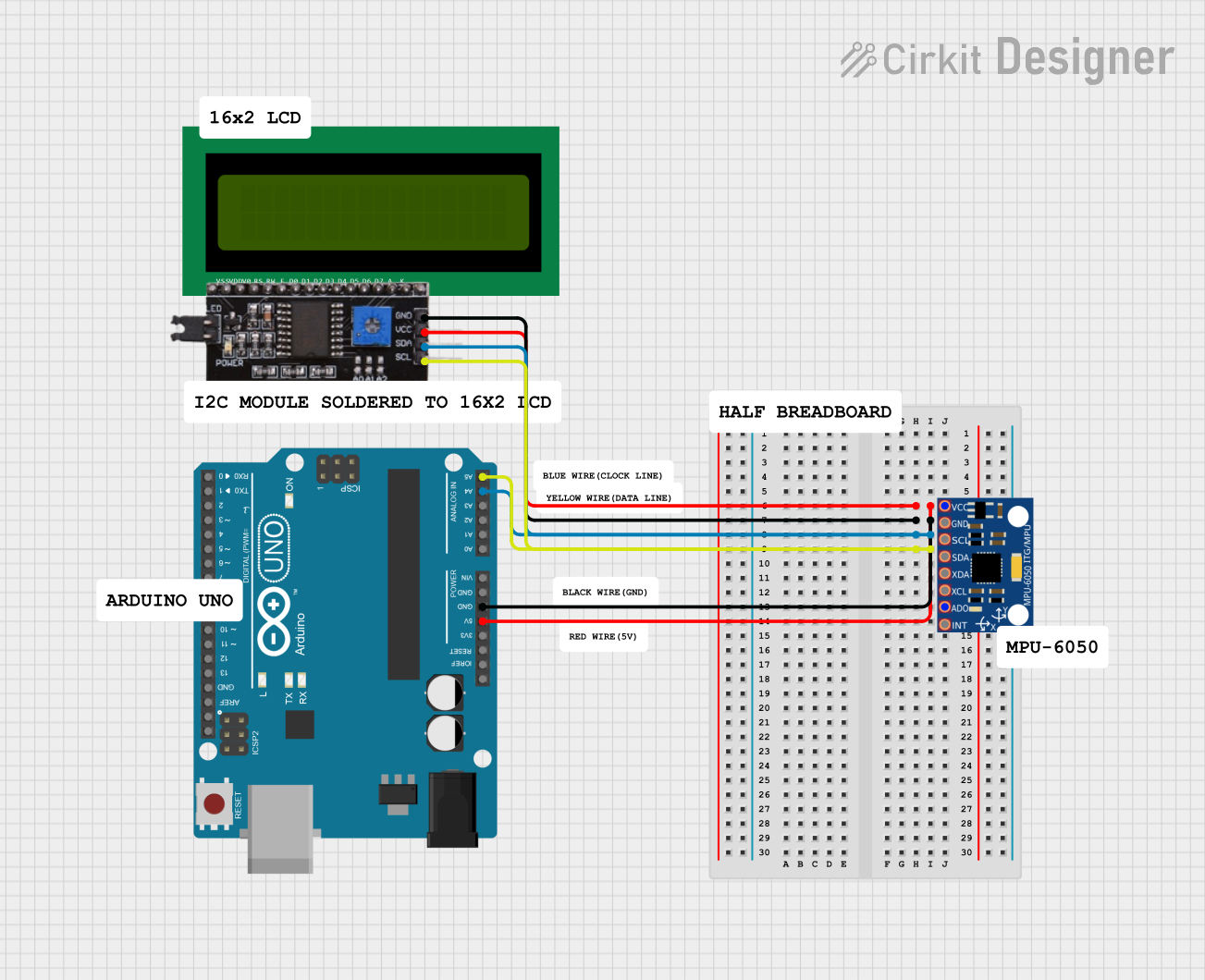
 Open Project in Cirkit Designer
Open Project in Cirkit Designer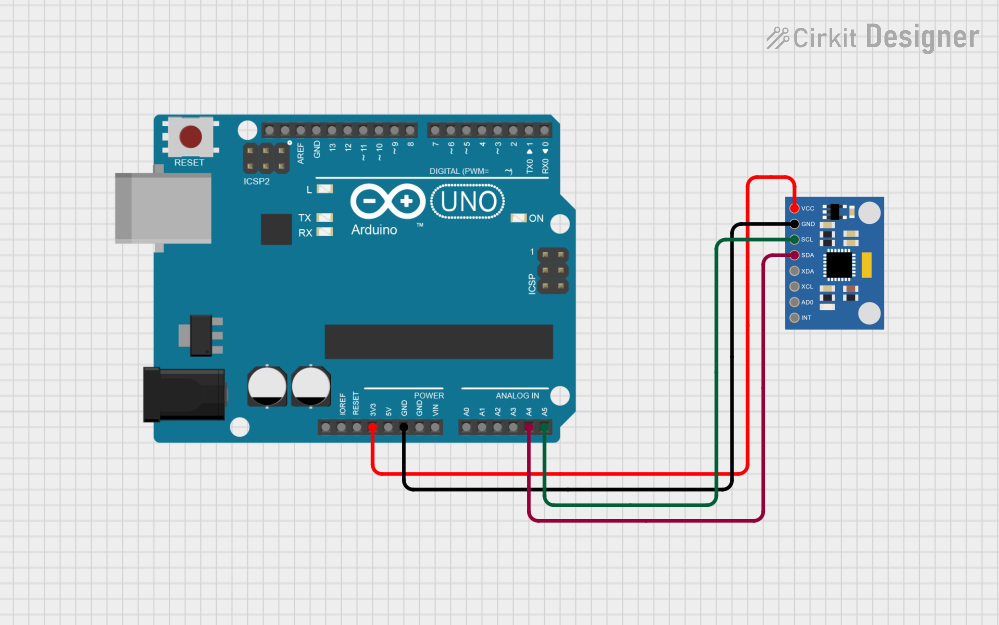
 Open Project in Cirkit Designer
Open Project in Cirkit DesignerExplore Projects Built with MPU6050

 Open Project in Cirkit Designer
Open Project in Cirkit Designer
 Open Project in Cirkit Designer
Open Project in Cirkit Designer
 Open Project in Cirkit Designer
Open Project in Cirkit Designer
 Open Project in Cirkit Designer
Open Project in Cirkit DesignerTechnical Specifications
The following are the key technical details of the MPU6050:
- Supply Voltage: 2.375V to 3.46V (3.3V typical)
- Communication Interface: I2C (up to 400kHz)
- Gyroscope Range: ±250, ±500, ±1000, ±2000 degrees/second
- Accelerometer Range: ±2g, ±4g, ±8g, ±16g
- Operating Temperature: -40°C to +85°C
- Power Consumption: 3.9mA (typical in active mode)
- Package: 24-pin QFN
Pin Configuration and Descriptions
The MPU6050 has 8 primary pins for operation. Below is the pinout description:
| Pin | Name | Description |
|---|---|---|
| 1 | VCC | Power supply input (2.375V to 3.46V, typically 3.3V). |
| 2 | GND | Ground connection. |
| 3 | SCL | I2C clock line. Connect to the microcontroller's I2C clock pin. |
| 4 | SDA | I2C data line. Connect to the microcontroller's I2C data pin. |
| 5 | AD0 | I2C address select. Connect to GND (address 0x68) or VCC (address 0x69). |
| 6 | INT | Interrupt output. Used to signal data availability or motion detection events. |
| 7 | FSYNC | Frame synchronization input. Optional, typically left unconnected. |
| 8 | RESV | Reserved. Do not connect. |
Usage Instructions
How to Use the MPU6050 in a Circuit
- Power Supply: Connect the VCC pin to a 3.3V power source and the GND pin to ground.
- I2C Communication: Connect the SCL and SDA pins to the corresponding I2C pins on your microcontroller. Use pull-up resistors (typically 4.7kΩ) on both lines if not already present on your board.
- I2C Address Selection: Set the AD0 pin to GND for the default I2C address (0x68) or to VCC for the alternate address (0x69).
- Interrupts (Optional): Connect the INT pin to a digital input pin on your microcontroller if you want to use interrupt-driven data reading.
Important Considerations and Best Practices
- Use decoupling capacitors (e.g., 0.1µF) near the VCC pin to reduce noise.
- Ensure proper pull-up resistors are used on the I2C lines for reliable communication.
- Avoid excessive vibrations or shocks to the sensor, as they may affect accuracy.
- Calibrate the sensor for your specific application to improve measurement precision.
Example Code for Arduino UNO
Below is an example of how to interface the MPU6050 with an Arduino UNO using the I2C protocol:
#include <Wire.h>
// MPU6050 I2C address (default is 0x68 when AD0 is connected to GND)
const int MPU6050_ADDR = 0x68;
// MPU6050 register addresses
const int PWR_MGMT_1 = 0x6B; // Power management register
const int ACCEL_XOUT_H = 0x3B; // Accelerometer X-axis high byte
void setup() {
Wire.begin(); // Initialize I2C communication
Serial.begin(9600); // Start serial communication for debugging
// Wake up the MPU6050 (it starts in sleep mode)
Wire.beginTransmission(MPU6050_ADDR);
Wire.write(PWR_MGMT_1); // Access power management register
Wire.write(0); // Set to 0 to wake up the sensor
Wire.endTransmission();
Serial.println("MPU6050 initialized");
}
void loop() {
// Request accelerometer data
Wire.beginTransmission(MPU6050_ADDR);
Wire.write(ACCEL_XOUT_H); // Start reading at ACCEL_XOUT_H register
Wire.endTransmission(false); // Send repeated start condition
Wire.requestFrom(MPU6050_ADDR, 6); // Request 6 bytes (X, Y, Z high and low)
if (Wire.available() == 6) {
int16_t accelX = (Wire.read() << 8) | Wire.read(); // Combine high and low bytes
int16_t accelY = (Wire.read() << 8) | Wire.read();
int16_t accelZ = (Wire.read() << 8) | Wire.read();
// Print accelerometer values
Serial.print("Accel X: "); Serial.print(accelX);
Serial.print(" | Accel Y: "); Serial.print(accelY);
Serial.print(" | Accel Z: "); Serial.println(accelZ);
}
delay(500); // Wait 500ms before the next reading
}
Troubleshooting and FAQs
Common Issues
No Data from the Sensor:
- Ensure the MPU6050 is powered correctly (3.3V on VCC and GND connected).
- Verify the I2C connections (SCL and SDA) and check for proper pull-up resistors.
- Confirm the I2C address (0x68 or 0x69) matches your configuration.
Inconsistent or Noisy Readings:
- Check for physical vibrations or shocks affecting the sensor.
- Use software filtering or the DMP for more stable readings.
- Ensure proper grounding and decoupling capacitors are in place.
I2C Communication Errors:
- Verify the I2C clock speed (should not exceed 400kHz).
- Check for loose or incorrect wiring.
FAQs
Q: Can the MPU6050 operate at 5V?
A: No, the MPU6050 operates at 3.3V. Use a level shifter if interfacing with a 5V microcontroller.Q: How do I calibrate the MPU6050?
A: Calibration involves determining and compensating for sensor offsets. Libraries likeMPU6050orMPU6050_DMP6for Arduino often include calibration routines.Q: Can I use the MPU6050 without the DMP?
A: Yes, you can directly read raw accelerometer and gyroscope data via I2C and process it in your microcontroller.Q: What is the maximum sampling rate of the MPU6050?
A: The MPU6050 supports a maximum sampling rate of 1kHz for both accelerometer and gyroscope data.